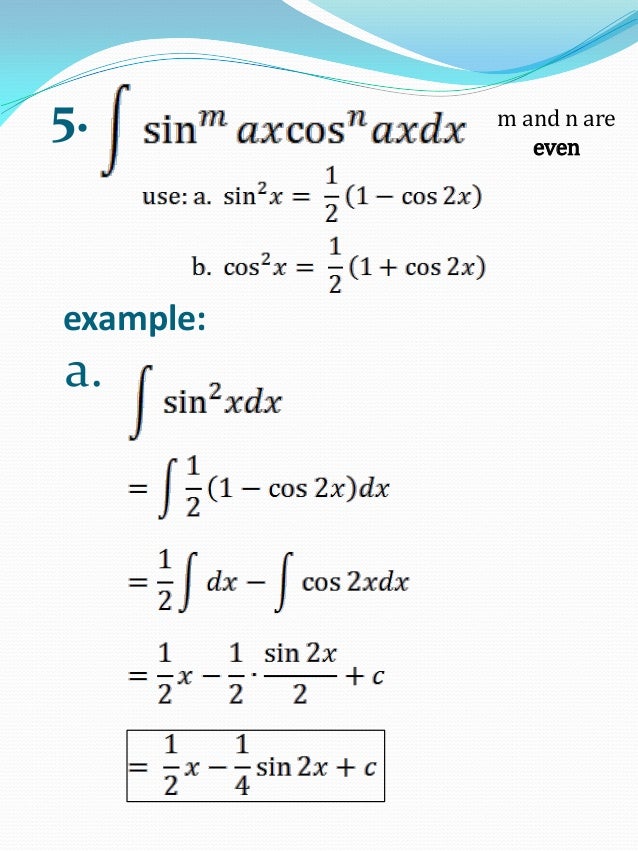
This absence of upper and lower limits leads to the name being indefinite integrals. Indefinite Integrals: In indefinite integrals, the notation used is the same but the only difference is the integrals do not have a pre-existing value of limits. The outcome of the definite integral of a function over a particular interval depends on the function and the interval but is independent of the variable of integration that is chosen to describe the independent variable. Also, you can understand that integral in maths deals with the problem that involves locating the area specified by the graph of a function under given conditions and depending on these types of integration in maths are:ĭefinite Integrals: The definite integralshave a unique value and are denoted by the symbol \(\int_a^bf\left(x\right)dx\) Integration is the inverse method of differentiation. The process of determining antiderivatives is named integration. The functions that would generate the function as a derivative are called antiderivatives of the function. So you'll see me using that notation in upcoming lessons.Integral Calculus in simple terms can be understood as the inverse process of differentiation.
#Integral calculus plus
So sometimes people will write in a set of brackets, write the anti-derivative that they're going to use for x squared plus 1 and then put the limits of integration, the 0 and the 2, right here, and then just evaluate as we did. When you're using the fundamental theorem of Calculus, you often want a place to put the anti-derivatives. Includes bibliographical references and index. An integral is the reverse of a derivative, and integral calculus is the opposite of differential calculus.A derivative is the steepness (or 'slope'), as the rate of change, of a curve. Introduction to integral Calculus : systematic studies with engineering applications for beginners / Ulrich L. So, consider an online integral solver that solves simple & complex integrals functions and shows you the step-by-step calculations. In calculus, an integral is the space under a graph of an equation (sometimes said as 'the area under a curve'). This is the exact value for the area under that curve and we got it using just a couple of calculations, the anti-derivative evaluated at 2 minus the anti-derivative evaluated at 0. Integral calculation is quite difficult to solve by hand, as it includes different complex integration formulas.

2 is 6 thirds so this is 14 thirds or about 4 and 2 thirds. So this is going to be our be our answer. Now capital f of 2 is one third of 2 cubed, one third of 2 cubed plus 2 minus capital f of 0 one third of 0 cubed plus 0. So this is going to equal capital f of 2 minus capital f of 0. So I need to evaluate this anti-derivative at 2 and then evaluate it at 0 and subtract. You can use any anti-derivative, it doesn't matter and that's why most people will choose to use the anti-derivative with a +0 here. Now it's also true that one third x cubed plus x plus 1 is an anti-derivative of x squared plus 1. I need an anti-derivative for it and an anti-derivative would be capital f of x equals one third x cubed plus x. In this integral from 0 to 2, this is my little f of x. So this is the integral I'm going to solve. That would be the integral from 0 to 2 of x squared plus 1 dx. Definition of the Definite Integral In this section we will formally define the definite integral, give many of its properties and discuss a couple of interpretations of the definite integral. So the exact area equals the definite integral of this function from 0 to 2.

Says find the exact area under y=x squared plus 1 from x=0 to x=2. So let's see how that works out in an example. So you can evaluate a definite integral exactly using an anti-derivative and just evaluating it and subtracting. This b is the same as this b, this a is the same as this a. So again capital F is an anti-derivative of this inside function. If f is a continuous function and capital F is an anti-derivative of little f then the definite integral from a to b of little f of x dx is capital F of b minus capital F of a.

I need to introduce a very important topic, "The Fundamental Theorem of Calculus." Here's the theorem right here.


 0 kommentar(er)
0 kommentar(er)
